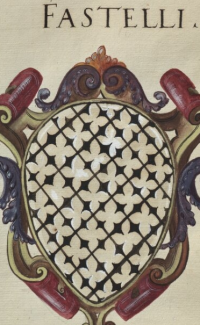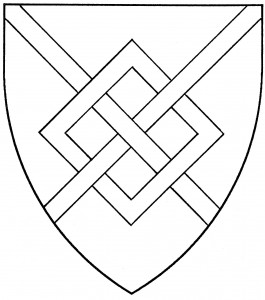Fret, Fretty, Fretted
WARNING: Do not cite this page as a reference. This page is on this wiki only to make the content "searchable" and easier to find. If you find the information you seek here, go to the original sources to verify the information and use them for your documentation.
Definitions:[edit | edit source]
Fret - A charge consisting of a bend and a bend sinister, interlaced with a mascle.
Fretty - A charge (not a field treatment!) consisting of bendlets interlaced with as many bendlets sinister, like a diagonal lattice.
Fretted - Sometime used to describe long narrow charges (such as arrows) that are interlaced in saltire
Illustrations:[edit | edit source]
Period:[edit | edit source]
| Bend | 
|
| Ingeram Codex, 1489, fretted bend | Insignia Florentinorum, BSB 277, fancy fretty (?) |
An Ordinary of Siebmacher's Wappenbuch[edit | edit source]
Modern:[edit | edit source]
Pictorial Dictionary of SCA Heraldry (3rd edition):[edit | edit source]

Vector Graphics:[edit | edit source]
- Book of Traceable Heraldic Art
- Viking Answer Lady - http://www.vikinganswerlady.com/Stars/Heraldry_SVG_Images/index.htm
Annotated Pennsic Traceable Art Project[edit | edit source]
Sources:[edit | edit source]
- Academy of St. Gabriel "Medieval Heraldry Archive" - http://www.s-gabriel.org/heraldry/
- Archive of St. Gabriel reports - [[1]]
- Laurel Armory Articles - http://heraldry.sca.org/laurel/armory_articles.html
- New Heraldic Primer (Heraldry for Non-Heralds) - http://heraldry.sca.org/armory/newprimer/
- Pictorial Dictionary of Heraldry (PicDic), 3rd Edition - http://mistholme.com/pictorial-dictionary-of-heraldry
- Period Armorials
- Parker's Heraldry - http://karlwilcox.com/parker/
- Riestap's Armorial Général - //http:www.euraldic.com/lasu/bl/bl_a_aa.html
Precedents:[edit | edit source]
Precedents of the SCA College of Arms - http://heraldry.sca.org/laurel/precedents.html
Morsulus Heralds Website - http://www.morsulus.org/ (to search the LoARs and Precedents)
Use the above links to be sure any precedents listed below haven't been superseded by newer precedents.
Definition:[edit | edit source]
October 2008 - nailed is circles at the intersections of the fret[edit | edit source]
"When fretty has circles at the intersections of the fret overlaps, it is termed 'nailed', such as "Argent fretty sable nailed Or." "Since commenters have found examples of the same device both nailed and not nailed in period, nailing...is not worth a CD." October 2008 LoAR
September 2006 - 3 frets couped is not equivalent to fretty:[edit | edit source]
"While a fret is an artistic variant of fretty, in this case, the three frets {couped} are not equivalent to fretty as they are not constrained to fill a space such as a field or an ordinary." September 2006 LoAR
January 1998 LoAR - fretty is equivalent to a single fret:[edit | edit source]
"The fretty is a charge equivalent to a single fret" January 1998 LoAR
November 1992 - fretty is an artistic variation of a fret[edit | edit source]
One of this month's submissions required a ruling on the status of fretty: should we consider it a field treatment, or a charge group? If a charge group, was it a semy, or an artistic variation of the fret, or a single charge in its own right? For many years, fretty was considered a field treatment (v. the 1986 Glossary of Terms). Mistress Alisoun specifically overturned this in the LoAR of 25 Feb 90, redefining fretty as "a `semy of frets' and as such contribut[ing] difference. ...Period treatises make it clear that fretty was seen as placed upon the field in the same way that ...other charges semy were strewn. ...Unlike `normal' field treatments, but like secondary charges, a `fretty' can itself be charged." Unfortunately, no period sources were cited.
- Master Da'ud, on the basis of further research, redefined fretty as an artistic variation of a fret: "Evidence has been presented that `a fret' and `fretty' were considered interchangeable in period, so no difference can be granted between them." [LoAR of July 90] However, some of his subsequent decisions (e.g. Miriel d'Estoile, LoAR of June 92, p.20) reverted to previous definitions. Clearly, fretty lends itself to many interpretations, and we need to select one and stick to it henceforth.
- I don't believe that fretty is a field treatment. Lord Crescent has suggested that the very concept of "field treatments" is a Society invention. I'm not prepared to endorse that suggestion: Siebmacher, 1605, gives examples of both masoning and papellony, and the former seems to be considered part of the field, akin to diapering. But even stipulating the existence of field treatments, fretty doesn't seem to be part of the field. The examples of fretty with tertiaries --- e.g. Hemeldene, c.1308, Argent, fretty gules semy-de-lys Or --- strongly suggests that the fretwork is a charge group.
- Should we consider fretty a semy, then? It's tempting to so define it; like other semys, it would then be the primary charge group when alone on the field, but would demote to a secondary charge group when an overall charge was added. If fretty were a semy, though, the next question would be, "Semy of what?" It could only be considered "semy of bendlets and scarpes", an interpretation supported by period heraldic tracts: the Argentaye Tract, c.1485, describes fretty as "cotises set and counter-set in the manner of a bend". But bendlets, as ordinaries, remain primary charges even when surmounted by overall charges: Just as Gules, six bendlets Or, overall a lion argent conflicts under our Rules with Gules, six bendlets Or, so would Gules, three bendlets and three scarpes interlaced Or, overall a lion argent conflict with Gules, three bendlets and three scarpes interlaced Or. If we define fretty to be "an unnumbered group of bendlets", then the fretty cannot behave like a regular semy.
- I am forced to conclude that fretty is an artistic variant of the fret, and therefore a single charge. Partially, this is from the evidence of heraldic tracts: most of those I consulted did not (as the Argentaye Tract did) give a verbal description of fretty, but rather defined it by illustration --- and in so doing, drew no substantive distinction between what we would call "fretty" and "a fret". [[2]], 1562, blazons both renderings as a frett; Bossewell, 1572, and [Guillim, 1610, follow Legh's lead on this. Bara], 1581, does the reverse, blazoning as fretté what we would call "a fret".
Better evidence is found in the actual display of armory using fretty/a fret. Nearly every individual bearing arms with a fret on one roll may be found bearing the same arms fretty on another roll: e.g. John Maltravers, late 13th Century, who bore Sable fretty Or on the St. George's Roll and Sable, a fret Or on the Parliamentary Roll. The equivalence held true through Tudor times: the FitzWilliam Roll, c.1530, gives the arms of Theobald Verdon (Or, a fret gules) as Or fretty gules. The equivalence even held true in the presence of other charges on the field: e.g. the arms of Amery St. Armand were seen both as Or fretty and on a chief sable three bezants and Or, a fret and on a chief sable three bezants, and the arms of Despencer were seen both as Quarterly argent and gules fretty Or, a bendlet sable and Quarterly argent and gules, a bendlet sable between two frets Or. The latter example was, again, valid through Tudor times. (Sources: Dictionary of British Arms, vol.I, pp.338-340; [Armory II], pp.454-460; and see also the visual examples in Foster's Dictionary of Heraldry, under the names of Maltravers, Harington/Haverington, and Belhuse/Bellewe.)
- The main reason that Gules fretty Or, overall a lion argent conflicts with Gules fretty Or lies not in how we consider fretty, but in how we consider overall charges. So long as overall charges, by definition, can never be primary charges, such conflicts will continue to exist. Such considerations cannot change the evidence, however; the majority of the evidence shows fretty and a fret to be interchangeable charges, artistic variations of one another, and we shall henceforth so treat them. (10 November, 1992 Cover Letter (September, 1992 LoAR), pp. 3-4)
- http://heraldry.sca.org/precedents/bruce/fret.html
Registerability:[edit | edit source]
(Restricted, Reserved, SFPP, OOP)
November 2015 - four needles fretted in mascle[edit | edit source]
Angharad verch Rees. The following device associated with this name was registered in November of 2015 (via the East): Gules, four double-pointed knitting needles fretted in mascle and on a chief Or three gouttes de sang.
January 2015 - four needles fretted[edit | edit source]
Stæina knýtir - The following badge associated with this name was registered in January of 2015 (via the East): (Fieldless) Four double-pointed knitting needles fretted in mascle purpure.
Conflict:[edit | edit source]
October 2008 - nailing is not worth a CD[edit | edit source]
"When fretty has circles at the intersections of the fret overlaps, it is termed 'nailed', such as "Argent fretty sable nailed Or." "Since commenters have found examples of the same device both nailed and not nailed in period, nailing...is not worth a CD." October 2008 LoAR
November 1992 - charges over fretty conflict check as overall charges[edit | edit source]
...The main reason that Gules fretty Or, overall a lion argent conflicts with Gules fretty Or lies not in how we consider fretty, but in how we consider overall charges. So long as overall charges, by definition, can never be primary charges, such conflicts will continue to exist. Such considerations cannot change the evidence, however; the majority of the evidence shows fretty and a fret to be interchangeable charges, artistic variations of one another, and we shall henceforth so treat them. (10 November, 1992 Cover Letter (September, 1992 LoAR), pp. 3-4)
January 1992 - no difference between fret vs fretty[edit | edit source]
"There is a CD for the changes to the tertiaries, but by prior Laurel precedent nothing for the change between a fret and fretty" January 1992 LoAR
Identifiability:[edit | edit source]
Collected Precedents:[edit | edit source]
- 2nd Tenure of Elisabeth de Rossignol (April 2011 - August 2011) - Collected Armory Precedents
- 1st Tenure of Elisabeth de Rossignol (May 2005 - July 2008) - FRET and FRETTY
- The 2nd Tenure of François la Flamme (October 2004 - May 2005) - FRET and FRETTY
- The Tenure of Shauna of Carrick Point (May 2004 - August 2004) - Collected Armory Precedents
- 1st Tenure of François la Flamme (August 2001 - April 2004) - Collected Armory Precedents
- The Tenure of Elsbeth Anne Roth (June 1999 - July 2001) - Collected Armory Precedents
- The Tenure of Jaelle of Armida (June 1996 - June 1999) - Single HTML Document
- 2nd Tenure of Da'ud ibn Auda (November 1993 - June 1996) -
- The Tenure of Bruce Draconarius of Mistholme (June 1992 - October 1993) - Collected precedents
- 1st Tenure of Da'ud ibn Auda (June 1990 - June 1992) -
- The Tenure of Alisoun MacCoul of Elphane (September 1986 - June 1990) - Collected Precedents
- The Tenure of Baldwin of Erebor (August 1984 - August 1986) - Single HTML Document
- The Tenure of Wilhelm von Schlüssel (August 1979 - August 1984) - Collected Precedents
- The Tenure of Karina of the Far West (December 1975 - June 1979) - Collected Precedents
- The Early Days (June 1971 - June 1975) - Collected Precedents
In the Ordinary[edit | edit source]
- Fret - Argent]
- Fret - Azure]
- Fret - Fur]
- Fret - Gules]
- Fret - Multicolor]
- Fret - Or]
- Fret - Purpure]
- Fret - Sable]
- Fret - Vert]
- Fretty - see Fret]